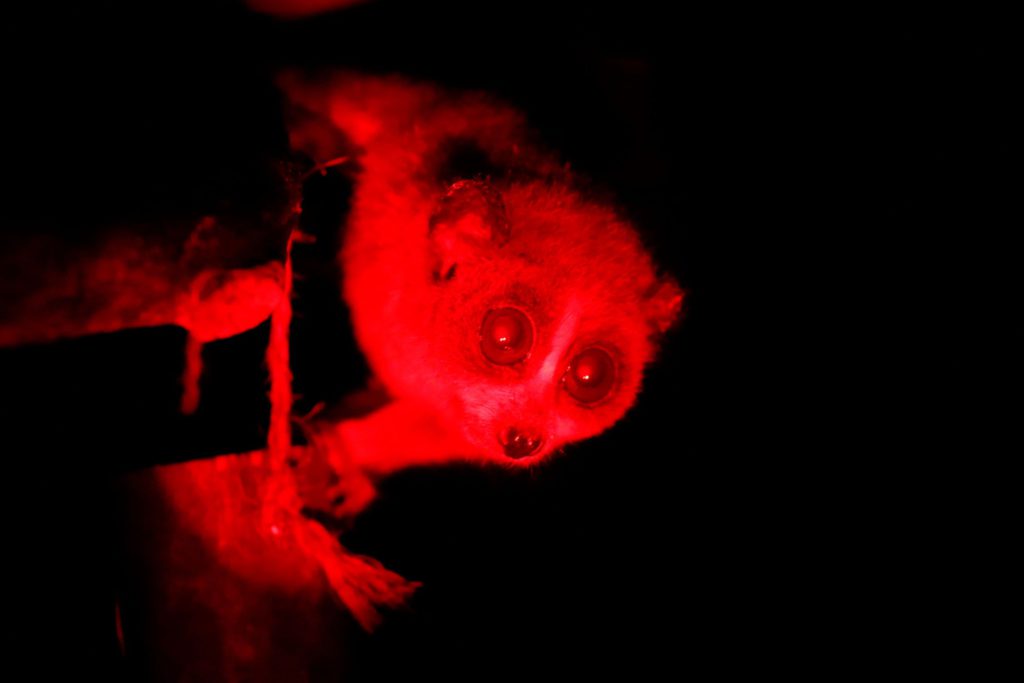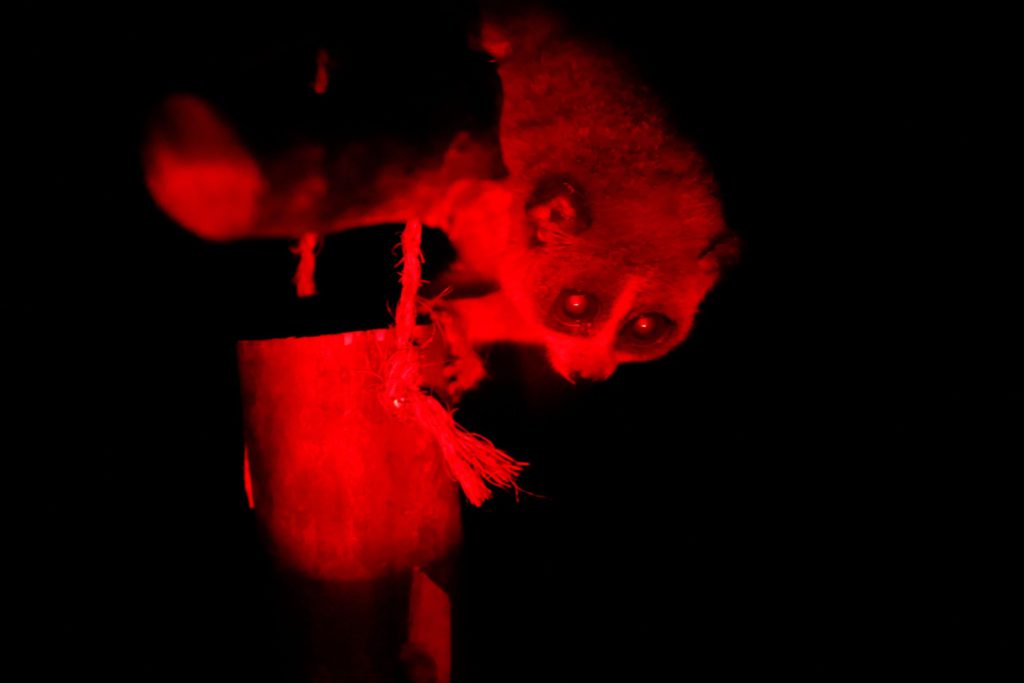
ASP Primate Welfare Award Winner (2022): Behavioral and fecal glucocorticoid profiles in the formation of all female social groups of pygmy slow lorises

Josue Alejandro received the Primate Welfare Award for his project titled: “Behavioral and fecal glucocorticoid profiles in the formation of all female social groups of pygmy slow lorises (Nycticebus pygmeaus).” Mr. Alejandro is a doctoral student at the Kyoto University Primate Research Institute in Japan. His award-winning work focuses on socially housing female pygmy slow lorises at the Japan Monkey Centre’s Slow Loris Conservation Centre in Inuyama, Japan. We interviewed him about his work, some of which is now published in Animals: Behavioral Changes of Solitary Housed Female Pygmy Slow Lorises (Nycticebus pygmeaus) after Introduction into Group Enclosures. Lorises are categorized as endangered on the IUCN Red List and are subject to capture from the wild for the illegal pet trade. Confiscated lorises reside in captivity for the remainder of their lives and are typically singly housed since they are known to occupy large home ranges and are reported to live relatively solitary lifestyles in the wild. To date, no study has examined the behavioral or physiological effects of socially housing pygmy slow lorises in captivity. This study assessed the welfare implications of group housing 8 female pygmy slow lorises. See below for an interview with Mr. Alejandro for more details regarding this project.
What is known about the social structures of pygmy slow lorises in the wild? Why have the social structures of pygmy slow lorises been hard to understand?
Unfortunately, detailed information on pygmy slow loris’s social systems is still unknown. However, in recent decades, fieldwork observation has revealed they may be more social than originally thought. For example, although studies of populations in Cambodia and Vietnam suggest little overlap between their home ranges, researchers have seen individuals nesting in trees that are close to each other. The main reasons why their social structures are not clearly known are that they are nocturnal, live high in the canopy, are usually found in dense forests, and high anthropogenic activities (hunting, deforestation, etc.) have led to low encounter rates in the wild.
How do slow lorises end up in captivity? How many slow lorises are known to be in captivity?
There are many ways lorises end up in captivity but the illegal wildlife trade probably plays the largest role (pets, medicine, etc.). There are ways in which lorises are still being sold online, which is difficult to regulate and prohibit. Additionally, some countries still allow the breeding of captive animals to be sold as pets. It is likely that the number of slow lorises is increasing at confiscation centers but decreasing in zoos, as they do not reproduce as well as other primates in captivity.

What are the typical housing conditions of slow lorises in captivity?
Most of the enclosures I’ve seen at zoos are light inverted, with spaces that allow the public to view them, and individuals are mostly housed alone. Meeting adequate captive conditions of confiscated slow lorises is challenging. They are sometimes housed in small cages at holding facilities indefinitely since their arrivals are never scheduled. Because the trade never stops, illegal wildlife trafficking doesn’t just become a conservation problem, but also an animal welfare issue.
What was your motivation for this study?
I was inspired by a talk by Dr. Anna Nekaris, who is a famous researcher on lorises, in 2016 while I was doing my masters in Japanese macaques. At the time, my colleague and supervisor Dr. Yamanashi was working with the male lorises. I helped her and the Slow Loris Conservation Center team of the Japan Monkey Centre build the naturalistic enclosures to which the lorises were going to be moved. I took the opportunity to perform focal observations on all of the females before and after pairing, to help to gather more data on this process of socially housing pygmy slow lorises, which had been seriously unreported until now.
Can you describe your social group formation process for this study? Have you refined the process over time?
The lorises were put in cages next to or facing their future cage mate. Just as many places do when pairing other primates, we wanted them to get acquainted with their pairing buddies and also to see if we noticed any signs of incompatibility or aggression. To prevent aggressive territorial behaviors and individual differences in familiarization with the space, we attempted to ensure that the new enclosures were unfamiliar to all potential cage mates. For 4 out of the 6 females, we had a type of tunnel system that connected two separate cages and a lot of enrichment for all animals. We would start 1-hour introduction pairing sessions with supervision and document any aggressive or affiliative interactions. If it seemed like they would not get along, then a new partner was assigned. The remaining group of 4 females was paired in an open enclosure, and we did not have as much control over the introduction. However, the introductions went exceptionally well. The first night, all the females slept in various places, but beginning the second night, all the females slept in the same nest together. This allowed us to learn about the pairing process of lorises; for example, indicators of successful pairs. Of course, I think there are ways we can improve the process going forward, such as trying to pair animals by personality and/or temperament and comparing success rates.
After grouping the female pygmy slow lorises at your facility, what behavioral changes did you observe? Were there any correlations between behavioral changes and physiological changes?
I think the biggest surprise was the amount of time they spent grooming each other, close to 10%. I was expecting a bit more avoidance or indifference, but they enjoyed each other’s company, as they spent a significant amount of time in close proximity. As for physiological changes, we did see a decrease in fecal cortisol after pairing the females together (unpublished data). We also saw a positive association between locomotion and fecal cortisol, with higher levels of cortisol found with higher levels of locomotion. Only one female exhibited stereotypy before pairing and had higher levels of cortisol than her partners. Her cortisol levels decreased after pairing and she did not continue to exhibit stereotypy. I think our findings mirror what has been seen in other species.
Did females sleep together? Did the same dyads of females nest together for the duration of the study?
Yes, and that was so cool! At first, when pairing the lorises, after a quick greeting to the other loris, they spent a lot of their time exploring the new enclosure. By the second night until the end of the study, they all slept in the same nest together. The group of 4 females all slept in the same nest every single night. The pair Mizuki and Nanten also nested every night but they shifted between nest location sites from time to time (the enclosure was two separate enclosures connected with tunnels so they could avoid each other if they chose to).

Do you see changes in group dynamics when a female is removed from a group to be paired with a male?
I would assume we would see differences once one of the cage mates is removed, but the female pairs were disbanded and then paired with males, and I did not continue the behavioral data collection for the male-female pairing process. Dr. Yamanashi continued observations and noted that they also had non-aggressive interactions but that they weren’t as fast to engage in affiliative behaviors compared with the female-female pairings that did so from the start.
Have you tried socially housing males together?
I have seen 5 successful pairings of males. Although they didn’t engage in affiliative interactions or share nest sites as quickly as females, and they showed aggressive interactions in the first week or so, all the pairs showed affiliative behaviors and shared sleeping sites without any serious aggressive interactions. Dr. Yumi Yamanashi worked on pairing the males together and studying their social interactions (published in AJP: Social relationships among captive male pygmy slow lorises (Nycticebus pygmaeus): Is forming male same-sex pairs a feasible management strategy?).
Do your study findings have implications for pygmy slow loris conservation? What implications do your findings have for the behavioral management of these primates?
I think the study has positive implications for pygmy slow loris conservation. By socially housing animals, we free up space to rescue more lorises from the illegal wildlife trade while also improving their captive lives (reducing stress). I also believe that it has implications for behavioral management for this species. Recent reports have shown that most confiscated animals remain in holding facilities, without ever being released. I hope that our findings motivate some institutions to at least attempt social housing.